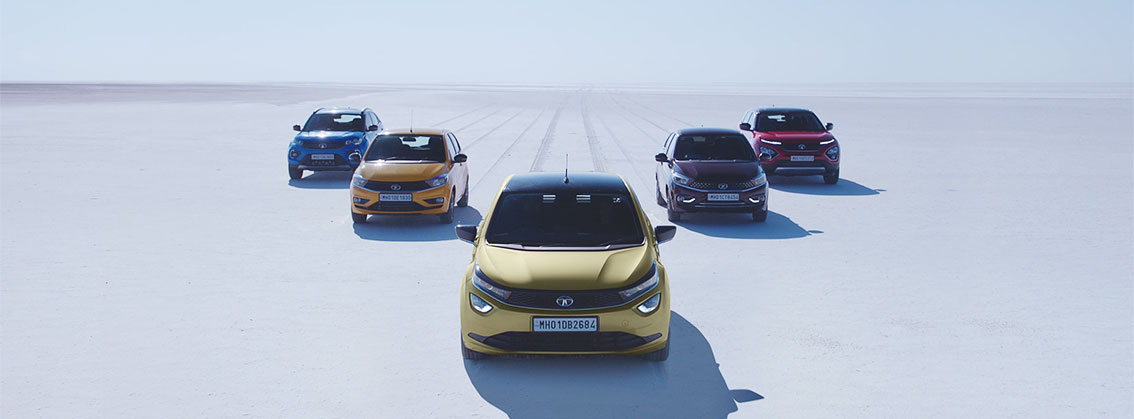Driven to Succeed: Inside Tata Motors’ Remarkable Comeback in the Indian Auto Scene
Maruti Suzuki has long been the undisputed leader of the Indian car market. They have successfully positioned themselves as symbols of affordability and reliability in the minds of customers, resulting in millions of trusted customers. Tata Motors, once regarded as distant competitors and failing contenders, is now making a dramatic comeback, challenging Maruti Suzuki’s dominance in the automobile business. Tata, a new challenger, has emerged from the ranks, shaking up the market with a strategy revamp and a renewed emphasis on innovation, resulting in a substantial shift in the balance of power. In this article, we look at Tata Motors’ incredible path to challenge Maruti Suzuki’s market share and emerge as a formidable competitor.
In this article, we look at the appealing narrative of Tata Motors’ return, including the key initiatives that pushed them forward and the impact they are having on Maruti Suzuki’s dominance. Buckle up, car enthusiasts and business enthusiasts alike, as we navigate the ups and downs of this real-life business thriller.
An Well-Known Favorite: Maruti Suzuki’s Legacy
The Maruti Suzuki success story is well-documented. Maruti first entered the Indian market in the 1980s with the iconic Maruti 800, a fuel-efficient and affordable car that particularly met the needs of India’s middle class buyers. Over the years, they established a reputation for reliability and value for money, and a diverse range of Hatchbacks such as the Alto and Wagon R dominated the sales charts.
However, the Indian automobile sector, like any dynamic ecosystem, was experiencing transformation. Consumer preferences were developing. SUVs and luxury hatchbacks became popular due to the need for more space, power, and a bolder look. Maruti Suzuki, with its predominantly hatchback-focused portfolio, began to show a weakness in its armour.
The Tata Mistake: Lessons Learned, Strategies Redefined:
Tata Motor’s Journey wasn’t always smooth sailing. Tata Motors suffered from product portfolio, quality, service responsiveness and also hurting them when one after another car launched by them was a flop which had an adverse impact on the brand.
Under determined leadership, Tata Motors embarked on a crucial transformation. They acknowledged the changing market dynamics.
So let see how Tata motors made its comeback with following things:
- Tata Motors Shifts Gears: Focusing on Future-Ready Vehicles
In 2019, Tata Motors sold models such as the Tata Indica, Bolt, Zest, Tata Sumo, and Hexa, which turned out to be total flops. This significantly decreased the market share and dealers’ profits due to low sales of Tata cars. As a result, Tata’s leadership made bold moves to discontinue production and phase out these models from the market. In order to make a comeback, they launched a series of stylish and feature-rich SUVs like the Nexon and Harrier, directly competing with established players such as the Hyundai Creta. These new offerings boasted bold aesthetics, premium interiors, and advanced features that resonated with a new generation of car buyers.
- Adapting to the Market Trends:
Tata aiming to replace Indica Vista Hatchback. The Tata Bolt was introduced in 2015. Nevertheless, It was eventually discontinued in 2019 after failing to draw in any customers. The model’s little sedan sibling, the Zest, likewise did not succeed in the sedan market that was popular with consumers at the time. Sales of the two models never really took off, and they were eventually discontinued despite being capable machines that were jam-packed with performance, features, and safety. Tough competition from dominant players like Maruti Suzuki and Hyundai was a big factor in these automobiles’ failure. And because the bolt carried over the Indica Design elements, many buyers were unimpressed. As India has a large population and mostly young buyers. Tata Motors targeted young buyers keeping in mind. SO Tata Launched Nexon, Altroz, Tiago and Punch, where the focus was on making the exterior aggressive, in which the wheel sizes would be the largest in the segment, the fenders would be strong and the road presence would be better. In addition, such an ambiance is created in the interior where the customer feels up-to-date and clutter-free and every feature is within his reach. The bold designs of Nexon and Atroz made these cars an instant hit.
- Shift in Car Build Quality: A Game-Changer in the Automobile Industry:
Prior to 2017, the safety and build quality of cars were not given much attention by the Indian auto industry. Major automakers Maruti and Hyundai placed a strong emphasis on building cars that are fuel-efficient. But with the introduction of the Tata Nexon in 2017, Tata Motors redefined the standards. In contrast to its rivals, Tata put safety before performance or design. By using Tata Steel to leverage their production edge in steel, they were able to purchase steel at cheaper rates and, as a result, manufacture vehicles at a lower cost.
- The Electric Vehicle Advantage: A Forward-thinking Leap
Tata Motors’ early introduction of electric vehicles (EVs) produced perhaps the biggest disruption. They established themselves as a leader in the Indian EV industry when other automakers were only analyzing the Indian markets and infrastructure or realizing the growing potential of this segment. Because they combined affordability, usefulness, and environmental friendliness, the Nexon EV and Tigor EV emerged as leaders in the market among purchasers who cared about the environment. Their quick action not only granted them an early advantage, but also established them as a brand that is prepared to take on the rapidly evolving mobility market.
This market is still difficult to navigate. Tata Motors has made a strong return with the introduction of new cars, particularly in the SUV class, as we can’t ignore the wind of change. In India, Maruti Suzuki Vitara Brezza continues to be the best-selling SUV. However, Maruti Suzuki still faces challenges in maintaining its market position in the SUV segment against companies like Tata Motors and Mahindra & Mahindra. Even though Maruti Suzuki is still very much in the lead, their market share is clearly declining. They now have to compete in a more cutthroat environment where success depends on creativity, innovation, and forward-thinking approach.
Unlocking Success: Essential Lessons for Aspiring Entrepreneurs:
Adapting to Changing Markets: Continuous success requires the ability to identify and address shifting consumer preferences. Companies who lose their way and stop adapting run the risk of falling behind.
Accepting Innovation: To be on the cutting edge, we must constantly innovate in our product offerings, technology, and design. Companies that put stagnation ahead of advancement are bound to face difficulties.
Developing a Future-Professional Brand: It’s critical to recognize and meet the needs of an audience that is forward-thinking. Companies will have a higher chance of long-term success if they adopt technology advancements and sustainability.


